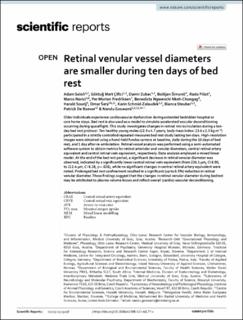| dc.contributor.author | Saloň, Adam | |
| dc.contributor.author | Çiftci, Göktuğ Mert | |
| dc.contributor.author | Zubac, Damir | |
| dc.contributor.author | Šimunič, Boštjan | |
| dc.contributor.author | Pišot, Rado | |
| dc.contributor.author | Narici, Marco | |
| dc.contributor.author | Fredriksen, Per Morten | |
| dc.contributor.author | Nkeh-Chungag, Benedicta Ngwenchi | |
| dc.contributor.author | Sourij, Harald | |
| dc.contributor.author | Šerý, Omar | |
| dc.contributor.author | Schmid-Zalaudek, Karin | |
| dc.contributor.author | Steuber, Bianca | |
| dc.contributor.author | De Boever, Patrick | |
| dc.contributor.author | Goswami, Nandu | |
| dc.date.accessioned | 2024-03-08T14:04:29Z | |
| dc.date.available | 2024-03-08T14:04:29Z | |
| dc.date.created | 2023-11-24T14:24:57Z | |
| dc.date.issued | 2023 | |
| dc.identifier.citation | Scientific Reports. 2023, 13 (1), . | en_US |
| dc.identifier.issn | 2045-2322 | |
| dc.identifier.uri | https://hdl.handle.net/11250/3121638 | |
| dc.description.abstract | Older individuals experience cardiovascular dysfunction during extended bedridden hospital or care home stays. Bed rest is also used as a model to simulate accelerated vascular deconditioning occurring during spaceflight. This study investigates changes in retinal microcirculation during a ten-day bed rest protocol. Ten healthy young males (22.9 ± 4.7 years; body mass index: 23.6 ± 2.5 kg·m–2) participated in a strictly controlled repeated-measures bed rest study lasting ten days. High-resolution images were obtained using a hand-held fundus camera at baseline, daily during the 10 days of bed rest, and 1 day after re-ambulation. Retinal vessel analysis was performed using a semi-automated software system to obtain metrics for retinal arteriolar and venular diameters, central retinal artery equivalent and central retinal vein equivalent, respectively. Data analysis employed a mixed linear model. At the end of the bed rest period, a significant decrease in retinal venular diameter was observed, indicated by a significantly lower central retinal vein equivalent (from 226.1 µm, CI 8.90, to 211.4 µm, CI 8.28, p = .026), while no significant changes in central retinal artery equivalent were noted. Prolonged bed rest confinement resulted in a significant (up to 6.5%) reduction in retinal venular diameter. These findings suggest that the changes in retinal venular diameter during bedrest may be attributed to plasma volume losses and reflect overall (cardio)-vascular deconditioning. | en_US |
| dc.language.iso | eng | en_US |
| dc.rights | Navngivelse 4.0 Internasjonal | * |
| dc.rights.uri | http://creativecommons.org/licenses/by/4.0/deed.no | * |
| dc.subject | bed rest | en_US |
| dc.subject | retinal vessel analysis | en_US |
| dc.subject | retinal arteriolar | en_US |
| dc.subject | venular diameters | en_US |
| dc.title | Retinal venular vessel diameters are smaller during ten days of bed rest | en_US |
| dc.title.alternative | Retinal venular vessel diameters are smaller during ten days of bed rest | en_US |
| dc.type | Peer reviewed | en_US |
| dc.type | Journal article | en_US |
| dc.description.version | publishedVersion | en_US |
| dc.rights.holder | © Te Author(s) 2023 | en_US |
| dc.subject.nsi | VDP::Medisinske Fag: 700 | en_US |
| dc.source.pagenumber | 7 | en_US |
| dc.source.volume | 13 | en_US |
| dc.source.journal | Scientific Reports | en_US |
| dc.source.issue | 1 | en_US |
| dc.identifier.doi | 10.1038/s41598-023-46177-x | |
| dc.identifier.cristin | 2201787 | |
| cristin.ispublished | true | |
| cristin.fulltext | original | |
| cristin.qualitycode | 1 | |

